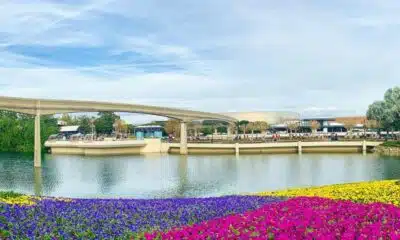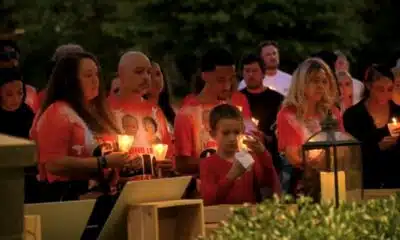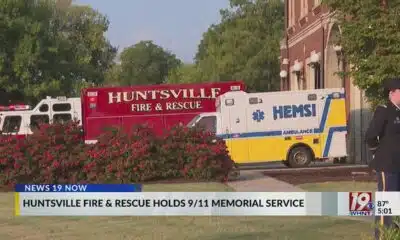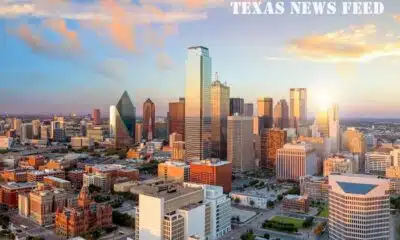News from the South - North Carolina News Feed
Enormous — and controversial — I-26 bridge over Patton Avenue, nixed years ago, is quietly revived in Connector plan • Asheville Watchdog
As it inches toward its billion-dollar I-26 Connector project, the North Carolina Department of Transportation has trumpeted its efforts to keep costs down, including $125 million in cuts it announced this week. But until now, it has not acknowledged a key measure in the tightening of the project’s budget: the revival of a controversial plan for an eight-lane interstate overpass that would cast its shadow on Patton Avenue in West Asheville.
The return of that idea, originally debated and killed in the late 2000s, is among the most significant changes to the I-26 Connector designs that have been available to the public since late 2018. Those plans called for the highway to go under Patton, not above it.
The transportation department approved the overpass concept more than a year ago, in July 2023, it said Friday. Until asked this week by Asheville Watchdog, state and city officials had not publicly acknowledged the flyover.
Designs and a rendering showing the bridge were included in an NCDOT presentation to Asheville City Council on Tuesday. Though the overpass went unremarked upon by city and state officials, the images shocked Joe Minicozzi, a certified city planner and the principal of the Urban3 planning group in Asheville.
Minicozzi worked with the city and the NCDOT on the project during his tenure as chairperson of the Asheville Design Center, a nonprofit that helped develop key designs for the long-gestating Connector project. He recalled the backlash when the flyover bridge was first proposed in 2008. He thought the idea was dead.
The overpass pitch, Minicozzi recalled, brought objections from numerous stakeholders. He saw the proposed structure — “an aircraft carrier of asphalt,” as he described it — as an eyesore, an impediment to development along one of the city’s crucial arteries, and a possible environmental hazard.
Minicozzi and others involved in the design process criticized the lack of transparency around the return of the plan for the bridge, which would cross near a former FedEx site at 628 Patton Ave. He said the change raises questions about whether the NCDOT has made other alterations outside the public eye and about the validity of the state’s environmental impact statement.
“I get it,” he said. “They’re throwing the highway over top of Patton Avenue because it’s easier to do. … They get to save maybe six months of construction time. Meanwhile, all the rest of us get to live with this for 100 years.”
$1.15 billion winning bid included flyover plan
Archer-Wright Joint Venture, the contractor that would ultimately win the bid for the Connector project, first proposed reviving the overpass as part of a pre-bid process in June 2023. The NCDOT signed off on the idea the following month, said Nathan Moneyham, the construction engineer for the NCDOT division that covers Buncombe and six other counties.
Archer-Wright included the concept in the $1.15 billion bid it submitted last year. Though the bid was docked points for conflicting with the state’s plan for the highway to go under Patton, the NCDOT said, it also made the project substantially cheaper — the reason Archer-Wright won the bid last May, after two other bids came in hundreds of millions of dollars over budget.
The transportation department said it believes that its environmental impact statement — a federally required part of the process that it finished in 2020, under the old design — still applies because the bridge remains within the scope of the impact study. And without the flyover, the agency said, “the project would have not been awarded and the Department would have had to delay the project indefinitely.”
Going over Patton eliminates the need to move buried utilities, said Tim Anderson, the district engineer for the NCDOT’s division over Buncombe. It also allows the agency to lower the height of other bridges in the project. And with cost considerations, he said, the flyover plan was “the only viable option” to keep the Connector, which has been in the works since 1989, on schedule to open in 2031. It also saves taxpayer dollars, Anderson said, another key consideration.
Return to flyover bridge remained out of view
But that change stayed out of public view. The Archer-Wright proposal wasn’t a public record under state law until it won the bid last May, and even with the NCDOT touting its latest budget reduction after months of cost-cutting work, the agency hasn’t published the contractor’s plan. Instead, its website still shows the 2018 designs that have the highway cutting under Patton.
The Watchdog reached out to Archer-Wright for comment but did not hear back by deadline.
Moneyham said in an email that the NCDOT delayed publishing the proposal while it went through the cost-cutting process. The Archer-Wright pitch is a public record, he acknowledged, but he said the agency couldn’t provide it until after the deadline for this story.
Minicozzi, who has followed the Connector project closely for more than 15 years, has never seen Archer-Wright’s proposal, he said.
Nor has State Sen. Julie Mayfield, D-Buncombe, who before being elected to the General Assembly was involved in the project for years as an Asheville City Council member and co-director of the environmental nonprofit MountainTrue. Mayfield is now a senior policy advisor at MountainTrue.
Mayfield said she learned of the flyover’s reemergence only during the cost-cutting effort that Archer-Wright and the NCDOT undertook after the bid selection. That process was done “outside the public eye,” she said, with some input from city officials but no open meetings.

“We never talked about the flyover piece, the overpass, because that has been settled for over a decade,” Mayfield said, referring to earlier meetings last year with NCDOT. “So that was not on anybody’s radar screens — that there was even a possibility of changing.”
In response to The Watchdog’s questions, city spokesperson Kim Miller deferred to the NCDOT, saying the design change “was part of the confidential design negotiations” between the agency and Archer-Wright.
In an email Wednesday to planners and architects who fought against the original flyover proposal, Mayfield criticized the lack of transparency by the NCDOT. Those who fought the idea decades ago, she acknowledged, will see its revival as “a betrayal.”
She also pointed to some victories in the cost-cutting process, including the elimination of a 20-foot wall near the Hillcrest public housing development that would have put those residents “in a hole.”
Mayfield later said she believes the NCDOT is correct that its environmental impact statement will remain valid with the flyover bridge change because “it doesn’t change the footprint or boundaries of the project.”
In her email, Mayfield said she viewed the flyover bridge change as a pragmatic concession.
“I look at it with a little more distance, and if this one (albeit big) regressive change was something that needed to happen for the overall project and its benefits to move forward, which is how it was presented, that didn’t seem like a fatal trade off,” she wrote.
City, county and design center originally pushed back at overpass idea
A consultant working with the state on the project first floated the overpass idea in 2008, and the NCDOT embraced it, public records show. But the city, Buncombe County, and the Asheville Design Center pushed back, arguing that the flyover would hamper the development of Patton as a pedestrian- and cyclist-friendly gateway between downtown and West Asheville.
They won, or so it seemed at the time.
In 2009, an NCDOT representative said the agency could build the interstate under Patton at no extra cost — and that doing so may in fact save money. The next year, the Design Center announced that it had landed on a revised plan with local and state officials that meant the “previous over-Patton design is no longer considered an alternative.” A Design Center report in February 2010 pegged the savings of running the interstate under Patton rather than over it at $13 million. (Moneyham said in an email Friday that “the significant cost to relocate utilities and phase construction were significantly more than previously estimated.”)

Chris Joyell, who became the Design Center’s director in 2009, said it “went to the mat” in opposition to the flyover bridge in 2008. When the NCDOT agreed to take I-26 under Patton Avenue, the center “saw it as a huge victory,” he said. The Design Center became part of MountainTrue, where Joyell now works, in 2017.
Mayfield said that the NCDOT will eventually show the public its latest plans in a “sort of an open house type thing,” and she hopes the department will listen to how residents respond to changes.
But NCDOT spokesperson David Uchiyama said in an email that these will be strictly informational sessions, “not a reopening of the public involvement” that informed the 2018 designs and 2020 environmental study.
And in her email this week, Mayfield suggested that the NCDOT would not be dissuaded.
“We challenged them on this change and said the community would be very unhappy,” she wrote, “but there didn’t seem to be an option to go back.”
Joyell, like Mayfield, said he was pleased with some of the recent changes, particularly ones that limit the project’s effects on neighborhoods east of the river. While the picture west of the French Broad is hard to swallow, he said, the NCDOT attributing the lower budget to the flyover likely means it will stay in the design.
“If that’s the justification, it’s really hard to counter that, right?” Joyell said. “No one is going to say, ‘Oh no, delay the project further.’”
Asheville Watchdog is a nonprofit news team producing stories that matter to Asheville and Buncombe County. Jack Evans is an investigative reporter who previously worked at the Tampa Bay Times. You can reach him via email at jevans@avlwatchdog.org. John Boyle has been covering Asheville and surrounding communities since the 20th century. You can reach him at (828) 337-0941, or via email at jboyle@avlwatchdog.org. The Watchdog’s local reporting during this crisis is made possible by donations from the community. To show your support for this vital public service go to avlwatchdog.org/support-our-publication/.
Related
The post Enormous — and controversial — I-26 bridge over Patton Avenue, nixed years ago, is quietly revived in Connector plan • Asheville Watchdog appeared first on avlwatchdog.org
News from the South - North Carolina News Feed
White House officials hold prayer vigil for Charlie Kirk
SUMMARY: Republican lawmakers, conservative leaders, and Trump administration officials held a prayer vigil and memorial at the Kennedy Center honoring slain activist Charlie Kirk, founder of Turning Point USA. Kirk was killed in Utah, where memorials continue at Utah Valley University and Turning Point USA’s headquarters. Police say 22-year-old Tyler Robinson turned himself in but has not confessed or cooperated. Robinson’s roommate, his boyfriend who is transitioning, is cooperating with authorities. Investigators are examining messages Robinson allegedly sent on Discord joking about the shooting. Robinson faces charges including aggravated murder, obstruction of justice, and felony firearm discharge.
White House officials and Republican lawmakers gathered at the Kennedy Center at 6 p.m. to hold a prayer vigil in remembrance of conservative activist Charlie Kirk.
https://abc11.com/us-world/
Download: https://abc11.com/apps/
Like us on Facebook: https://www.facebook.com/ABC11/
Instagram: https://www.instagram.com/abc11_wtvd/
Threads: https://www.threads.net/@abc11_wtvd
TIKTOK: https://www.tiktok.com/@abc11_eyewitnessnews
News from the South - North Carolina News Feed
Family, friends hold candlelight vigil in honor of Giovanni Pelletier
SUMMARY: Family and friends held a candlelight vigil in Apex to honor Giovanni Pelletier, a Fuquay Varina High School graduate whose body was found last month in a Florida retention pond. Giovanni went missing while visiting family, after reportedly acting erratically and leaving his cousins’ car. Loved ones remembered his infectious smile, laughter, and loyal friendship, expressing how deeply he impacted their lives. His mother shared the family’s ongoing grief and search for answers as authorities continue investigating his death. Despite the sadness, the community’s support has provided comfort. A celebration of life mass is planned in Apex to further commemorate Giovanni’s memory.
“It’s good to know how loved someone is in their community.”
More: https://abc11.com/post/giovanni-pelletier-family-friends-hold-candlelight-vigil-honor-wake-teen-found-dead-florida/17811995/
Download: https://abc11.com/apps/
Like us on Facebook: https://www.facebook.com/ABC11/
Instagram: https://www.instagram.com/abc11_wtvd/
Threads: https://www.threads.net/@abc11_wtvd
TIKTOK: https://www.tiktok.com/@abc11_eyewitnessnews
News from the South - North Carolina News Feed
NC Courage wins 2-1 against Angel City FC
SUMMARY: The North Carolina Courage defeated Angel City FC 2-1 in Cary, ending their unbeaten streak. Monaca scored early at the 6th minute, followed by Bull City native Brianna Pinto’s goal at the 18th minute, securing a 2-0 halftime lead. Angel City intensified in the second half, scoring in the 88th minute, but the Courage held firm defensively to claim victory. Pinto expressed pride in the win, emphasizing the team’s unity and playoff ambitions. Nearly 8,000 fans attended. Coverage continues tonight at 11, alongside college football updates, including the Tar Heels vs. Richmond game live from Chapel Hill.
Saturday’s win was crucial for the Courage as the regular season starts to wind down.
https://abc11.com/post/north-carolina-courage-wins-2-1-angel-city-fc/17810234/
Download: https://abc11.com/apps/
Like us on Facebook: https://www.facebook.com/ABC11/
Instagram: https://www.instagram.com/abc11_wtvd/
Threads: https://www.threads.net/@abc11_wtvd
TIKTOK: https://www.tiktok.com/@abc11_eyewitnessnews
-
News from the South - North Carolina News Feed6 days ago
What we know about Charlie Kirk shooting suspect, how he was caught
-
News from the South - North Carolina News Feed6 days ago
Federal hate crime charge sought in Charlotte stabbing | North Carolina
-
Our Mississippi Home5 days ago
Screech Owls – Small but Cute
-
News from the South - Arkansas News Feed6 days ago
NW Arkansas Championship expected to bring money to Rogers
-
News from the South - Alabama News Feed7 days ago
Huntsville Fire & Rescue Holds 9/11 Memorial Service | Sept. 11, 2025 | News 19 at 5 p.m.
-
News from the South - North Carolina News Feed6 days ago
Under pressure, some immigrants are leaving American dreams behind
-
News from the South - Texas News Feed6 days ago
Safe Central Texas meet-up spots for online purchases
-
Mississippi News Video6 days ago
Mississippi Science Fest showcases STEAM events, activities
















































